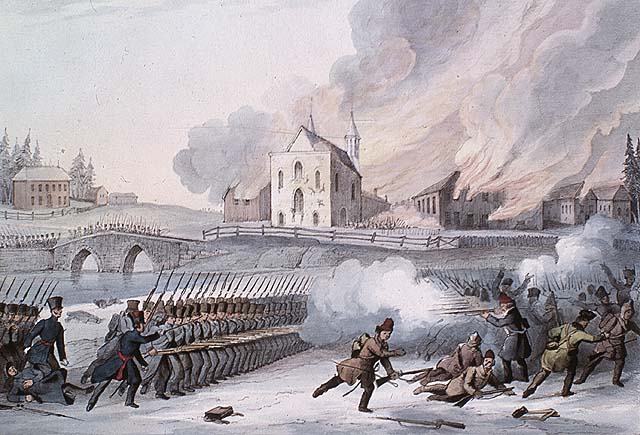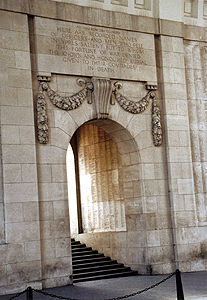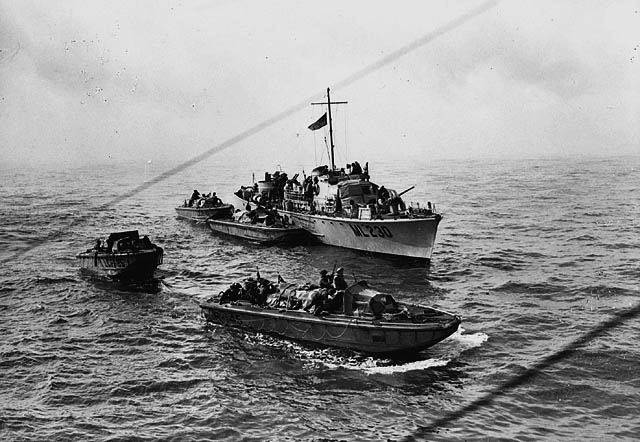Seven Years War
Battle of the Plains of Abraham
The Battle of the Plains of Abraham (13 September 1759) was a pivotal moment in the Seven Years War and in the history of Canada. A British invasion force led by General James Wolfe defeated French troops under the Marquis de Montcalm, leading to the French surrender of Quebec to the British. The French never recaptured Quebec and effectively lost control of New France in 1760.

Battle of Sainte-Foy
The Battle of Sainte-Foy (28 April 1760) was fought at Sainte-Foy, near Quebec City, during the Seven Years War. François de Lévis and his French force of 5,000 engaged 3,900 British troops under Colonel James Murray outside the city walls, soundly defeating them. Lévis then laid siege to the town while awaiting reinforcements from France. However, British ships arrived first, and Lévis retreated to Montreal.
Battle of Restigouche
The Battle of Restigouche (22 June to 8 July 1760) was the last naval battle fought in North America during the Seven Years War. The battle took place on the Restigouche River between the British and French, who were supported by Acadian and Mi’kmaq allies.
War of 1812
Battle of Queenston Heights
The Battle of Queenston Heights (13 October 1812) was one of the most famous battles of the War of 1812. The British, along with Haudenosaunee warriors, fought back the Americans, but suffered the loss of one of their most important leaders, Isaac Brock (see also Battle of Queenston Heights National Historic Site of Canada).
Battle of Stoney Creek
The Battle of Stoney Creek (6 June 1813) was a night attack of an American encampment during the War of 1812. Along with the Battle of Beaver Dams two weeks later, the engagement at Stoney Creek returned the Niagara Peninsula to British and Canadian control and ended the United States’ attempt to conquer the western part of the province.
Battle of Beaver Dams
The Battle of Beaver Dams (24 June 1813) was the largest First Nations victory in the War of 1812 (see First Nations and Métis Peoples in the War of 1812). A force of 300 Kahnawake and 100 Mohawk warriors from both Upper and Lower Canada, with British regulars in support, forced the surrender of nearly 500 advancing American soldiers near Beaver Dams (now Thorold, Ontario). The British, and their First Nations allies, had been warned of the American attack by Laura Secord.

Battle of Châteauguay
The Battle of Châteauguay (25–26 October 1813) was fought along the marshy shores of the Châteauguay River near Montreal during the War of 1812. Lieutenant Colonel Charles-Michel de Salaberry’s force of militiamen, Voltigeurs Canadiens, fencibles and Kahnawake warriors defended against some 3,000 Americans intent on invading Lower Canada and capturing Montreal (see also Battle of the Châteauguay National Historic Site).
Battle of Crysler’s Farm
The Battle of Crysler's Farm (11 November 1813) was fought on a farmer’s field between Morrisburg and Cornwall, along the shores of the St. Lawrence River. The battle was the Americans’ last attempt at capturing Montreal and was considered by many to be a disastrous defeat for their army during the War of 1812 (see also Battle of Crysler’s Farm National Historic Site of Canada).
Battle of Lundy's Lane
The Battle of Lundy’s Lane (25 July 1814) was fought between American troops and British regulars assisted by Canadian fencibles and militia and Indigenous warriors during the War of 1812. It was one of the most important battles of the war, halting the American advance into Upper Canada (see also Battle of Lundy’s Lane National Historic Site of Canada).
Battle of Lake Erie (Put-in-Bay)
The Battle of Lake Erie, also known as the Battle of Put-in-Bay (10 September 1813), was a naval battle fought by the United States Navy and the British Royal Navy in western Lake Erie during the War of 1812. The Americans gained command of Lake Erie after the battle and the British fell back up the Thames River near Moraviantown (see also War on the Lakes in the War of 1812).
Battle of the Thames (Moraviantown)
The Battle of the Thames, sometimes called the Battle of Moraviantown (5 October 1813), was a decisive American victory over the British and their Indigenous allies. During the battle, Shawnee chief Tecumseh was killed.
Battle of Plattsburgh
The Battle of Plattsburgh, also known as the Battle of Lake Champlain (6–11 September 1814), was a joint land and naval invasion of upper New York State and the last major British operation of the War of 1812 (not including the battles after the Treaty of Ghent).
Pemmican Wars
Battle of Seven Oaks
The Battle of Seven Oaks (19 June 1816) was a culmination of the escalating fur trade disputes between the Hudson’s Bay Company and the North West Company. About 60 Métis and First Nations men, led by Cuthbert Grant, were confronted by HBC Governor Robert Semple and 28 men. In the ensuing gunfight, Semple and 20 of the HBC party were killed.

Rebellions of 1837–38
Battle of Saint-Denis
The Battle of Saint-Denis (23 November 1837) was the first major engagement between Patriote rebels and government forces during the rebellion in Lower Canada. Forces under Colonel Charles Gore suffered a minor defeat to the Patriotes at Saint-Denis.
Battle of Saint-Charles
The Battle of Saint-Charles (25 November 1837) was fought two days after the Battle of Saint-Denis. Government troops led by Lieutenant Colonel George Wetherall marched on Saint-Charles and defeated the Patriotes after two hours.

Battle of Saint-Eustache
The Battle of Saint-Eustache (14 December 1837) brought the first rebellion in Lower Canada to a close. British commander-in-chief, Sir John Colborne, captured St-Eustache after fierce resistance from the habitants under the leadership of Jean-Olivier Chénier. The battle was followed by widespread looting and burning of French Canadian settlements by British volunteers.
Battle of Windmill
The Battle of Windmill (12–16 November 1838) was one of a series of raids launched along the Canada–United States border in the summer and fall of 1838 by the Hunters’ Lodges, secret societies established by Canadian rebels who had taken refuge in the northern United States after the failed rebellions of 1837–38.
Fenian Raids
Battle of Ridgeway
The Battle of Ridgeway (2 June 1866) was one of several Fenian raids, armed incursions into Canadian territory, between 1866 and 1871. Approximately 850 Canadian soldiers clashed with some 750 Fenians, Irish American insurgents, who had crossed the Niagara River from Buffalo, New York. It was the first industrial-era battle to be fought by Canadians, the first to be fought exclusively by Canadian troops and led entirely by Canadian officers.

North-West Resistance
Battle of Duck Lake
The Battle of Duck Lake (26 March 1885) is considered to be the first engagement of the North-West Resistance. A force of about 100 North-West Mounted Police (NWMP) and armed citizen volunteers under the command of Superintendent Leif Crozier met a large group of Métis and Indigenous resisters outside Duck Lake. The battle ended quickly, with the police and volunteers retreating to Fort Carlton.
Battle of Cut Knife
The Battle of Cut Knife (2 May 1885) was fought during the North-West Resistance. After six hours of fighting, Lieutenant-Colonel William Otter, in command of 300 soldiers, retreated from Cree and Assiniboine warriors led by Poundmaker and Cree war chief Fine Day.
Battle of Batoche
The Battle of Batoche (9–12 May 1885) was the last significant battle of the North-West Resistance. Less than 300 Métis, Cree and Dakota (Sioux) resisters led by Louis Riel and Gabriel Dumont were defeated by 900 federal government militia troops under Major-General Frederick Middleton, effectively bringing an end to the resistance. Riel surrendered a few days later and was eventually tried and hanged for treason.

Battle of Frenchman’s Butte
The Battle of Frenchman’s Butte (28 May 1885) was fought in the waning days of North-West Resistance. The Alberta Field Force under General Thomas Strange fought the indecisive battle against war chief Wandering Spirit and Cree warriors. They fired at each other from long range for several hours before both sides retreated.
Battle of Steele Narrows
The Battle of Steele Narrows (3 June 1885) was the scene of the last shots fired in the North-West Resistance. Often called the Battle of Loon Lake, it was a minor skirmish between about 65 men under Sam Steele and Woods and Plains Cree retreating after the Battle of Frenchman’s Butte. Four Cree were killed, including prominent Woods Cree chief Cut Arm.
South African War
Battle of Paardeberg
The Battle of Paardeberg (18–27 February 1900), fought during the South African War, was the first time that men in Canadian uniform, fighting in a Canadian unit, made war overseas. Canadian soldiers under William Otter helped pin down some 4,000 Boers, forcing their surrender. It was the first significant British victory of the war. Hundreds of men on both sides, including 31 Canadians, died at Paardeberg.

Battle of Leliefontein
The Battle of Leliefontein (7 November 1900) was fought during the South African War. A British force of 1,500 men was attacked by a large group of Boers on horseback, intent on capturing the supply wagons, and the guns of the Royal Canadian Artillery, at the rear of the column. For two hours, Canadian artillery crews, and soldiers of the Royal Canadian Dragoons, fought a wild, mounted battle to protect the guns.
First World War
Second Battle of Ypres
The Second Battle of Ypres (22 April to 25 May 1915) was the first major battle fought by Canadian troops in the First World War. The untested Canadians experienced the first large-scale poison gas attack in modern history and held a strategically critical section of the Ypres salient until reinforcements arrived. More than 6,500 Canadians were killed, wounded or captured.
Battle of Mount Sorrel
The Battle of Mount Sorrel (2–13 June 1916) was fought to gain control of a strategic hill in the Ypres salient in Belgium during the First World War. Thousands of Canadians were killed and wounded in the fighting.
Battle of the Somme
The Battle of the Somme (1 July to 18 November 1916) lasted five months, killed or wounded approximately 1.2 million men, and produced little gains. The Canadian Corps (see Canadian Expeditionary Force) was only involved in the final three months of fighting; however, on the offensive’s first day, the Royal Newfoundland Regiment was nearly annihilated at Beaumont-Hamel.
Battle of Vimy Ridge
The Battle of Vimy Ridge (9–12 April 1917), during the First World War, is Canada’s most celebrated military victory — an often mythologized symbol of the birth of Canadian national pride and awareness. Four divisions of the Canadian Corps captured the ridge from the German army in what was the largest territorial advance of any Allied force to that point in the war. More than 10,500 Canadians were killed and wounded in the assault.
Battle for Hill 70
The Battle for Hill 70 (15–25 August 1917) was an important Canadian victory during the First World War, and the first major action fought by the Canadian Corps under a Canadian commander, Lieutenant General Arthur Currie. The battle gave the Allied forces a crucial strategic position overlooking the occupied city of Lens.
Battle of Passchendaele
The Battle of Passchendaele (31 July to 10 November 1917), also known as the Third Battle of Ypres, took place on the Ypres salient in Belgium. Canadians captured a strategic ridge on 6 November, despite heavy rain and shelling that turned the battlefield into a quagmire. Nearly 16,000 Canadians were wounded or killed. The Battle of Passchendaele did nothing to help the Allied effort and became a symbol of the senseless slaughter of the First World War.

Battle of Amiens
The Battle of Amiens (8–12 August 1918) was the first in a string of offensive successes that led to the end of the First World War and culminated in the 11 November 1918 armistice (seeCanada’s Hundred Days). In their sector of the attack, the Canadians pushed the Germans back as many as 12 km, a huge achievement in a war often fought over metres. It came at the cost of 1,036 Canadians killed, 2,803 injured and 29 taken prisoner.
Second World War
Battle of the Atlantic
The Battle of the Atlantic (1939–45) was the longest continuous battle of the Second World War. Canada played a key role in the Allied struggle for control of the North Atlantic, as German submarines worked furiously to cripple the convoys shipping crucial supplies to Europe. Victory was costly: more than 70,000 Allied seamen, merchant mariners and airmen lost their lives, including 4,600 Canadians.
Battle of Britain
The Battle of Britain (10 July to 31 October 1940) was the first battle of the Second World War fought mainly in the air. After nearly four months of anxious combat, the Royal Air Force’s (RAF) Fighter Command stopped the German air force’s attempt, in advance of a planned invasion, to dominate the skies over southern and eastern England. Hundreds of Canadian air and ground crew participated in the battle, most as members of the RAF (see also Royal Canadian Air Force).
Battle of Hong Kong
The Battle of Hong Kong (8–25 December 1941) was the first land battle Canadians fought in the Second World War. Almost 2,000 troops from Winnipeg and Quebec City fought bravely against the invading Japanese force. When the British colony surrendered on Christmas Day, 290 Canadians had been killed in the fighting. Another 264 would die over the next four years, amid the inhumane conditions of Japanese prisoner-of-war camps.

Dieppe Raid
The Dieppe Raid (19 August 1942) was a major raid launched by the Allies on the French coastal port of Dieppe during the Second World War. Operation Jubilee was the first Canadian Army engagement in the European theatre of the war and was designed to test the Allies’ ability to launch amphibious assaults against Adolf Hitler’s “Fortress Europe.” The raid was a disaster: more than 900 Canadian soldiers were killed, and thousands more were wounded and taken prisoner.
Battle of Ortona
The Battle of Ortona (December 1943) was part of the Allied advance through Italy during the Second World War (see Italian Campaign). Canadian forces fought one of their toughest battles of the war in a bid to capture the town of Ortona. The month-long campaign — first at the Moro River outside Ortona, then with vicious street fighting in the town itself — cost more than 2,300 Canadian casualties, but eventually won Ortona for the Allies.
D-Day and the Battle of Normandy
The Battle of Normandy (from the D-Day landings on 6 June to the encirclement of the German army at Falaise on 21 August 1944) was one of the pivotal events of the Second World War and the scene of some of Canada’s greatest feats of arms. Canadian sailors, soldiers and airmen played a critical role in the Allied invasion of Normandy, beginning the bloody campaign to liberate Western Europe from Nazi occupation. Nearly 150,000 Allied troops landed or parachuted into the invasion area on D-Day, including 14,000 Canadians at Juno Beach.
Liberation of the Netherlands
The Liberation of the Netherlands (September 1944 to April 1945) was fought in the final months of the Second World War. The First Canadian Army fought German forces on the Scheldt estuary — opening the port of Antwerp for Allied use — and then cleared northern and western Netherlands of Germans, allowing food and other relief to reach millions of desperate people.
Battle of the Rhineland
The Battle of the Rhineland (8 February to 10 March 1945) was an allied offensive operation to occupy the Rhineland and secure passage over the Rhine River. The First Canadian Army (with British and American formations in support) under General Harry Crerar succeeded in forcing the Germans back to the east bank of the Rhine River, the last line of German defence.
Korean War
Battle of Kapyong
The Battle of Kapyong (22–25 April 1951) was one of Canada’s greatest, yet least-known, military achievements. A battalion of roughly 700 Canadian troops helped defend a crucial hill in the front lines of the Korean War against a force of about 5,000 Chinese soldiers. Besieged by waves of attackers, the Canadians held their position amid the horror of close-combat until the assaulting force had been halted and the Canadians could be relieved.

 Share on Facebook
Share on Facebook Share on X
Share on X Share by Email
Share by Email Share on Google Classroom
Share on Google Classroom


